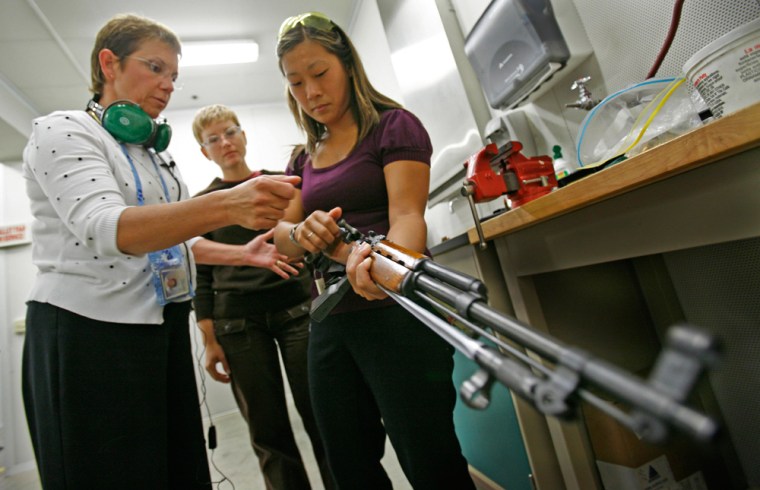Kelly Johnson snips pieces from a blood-stained, blue-striped shirt, then swabs the neck and armpits for sweat. Down the hall, Samantha Glass watches as a chemical reaction reveals a fingerprint on a juice bottle.
In the state's Eastern lab, Julie Price fires a .45-caliber pistol into a long metal water tank.
Unlike their counterparts on TV, they're not wearing low-cut shirts or stiletto heels, and their hair and makeup aren't always perfect. These are the real women of forensic science, and there are plenty of them.
An Associated Press review of accredited forensic science programs in the United States found about 75 percent of graduates are women, an increase from about 64 percent in 2000.
Women say they were drawn to forensic science by strong role models, a desire to help people and stability that's often lacking in other scientific careers.
Those in the field estimate that the nation's forensic labs are at least 60 percent female. At Virginia's Department of Forensic Science, 36 of 47 scientists hired since 2005 were women.
"I used to tell people when I first came that we considered forensic science Boys Town, but now it's more like a girls world," said Sylvia Buffington-Lester, 58, a supervisor in the latent print division who was the only woman in that division when she started in 1987.
West Virginia University professor Max Houck, chairman of a committee that accredits the field's academic programs, is researching what draws women to the sometimes gruesome world of forensics.
Among other factors, he cites the "CSI effect," saying the popular CBS show and its spinoffs were the first to show a proportional number of women in leading scientific roles. Other popular shows featuring female forensic investigators, including "Bones" and "Crossing Jordan," have followed.
"I have to think that there's got to be some relationship between the roles that are represented on TV and the way women see what's possible for them as a career," Houck said.
Forensic scientists say the attention from the shows has brought more people into the field, even if they are initially drawn to the glamorous work portrayed on television. Even while poking at dead bodies, the female scientists on shows like "CSI: Miami" often don revealing blouses and always have makeup jobs fresh out of a beauty salon.
"A lot of them do realize that riding around in the Hummers and wearing Prada is not the day-to-day things," Buffington-Lester said. "But I tell girls that I do a lot of things in pearls and pumps ... you can be a part of this used-to-be male-dominated thing but you can still be feminine, you can still be who you are."
Female forensic scientists also point to characters like crime writer Patricia Cornwell's Dr. Kay Scarpetta, the chief medical examiner in a string of best-selling thrillers.
Women entering the field today grew up when girls were being encouraged to study science. Even the Girl Scouts have an "Uncovering the Evidence" badge, trimmed in pink with a silver fingerprint.
Some say they became forensic scientists out of a desire to help people — both to find the bad guy and clear the innocent one.
"I think all of us have kind of an altruist bent for the greater good, because we could probably be doing research, chemistry or medical and making more money, but everybody seems to have a passion for the science and work and wanting to help people," said Glass, 36, a supervisor in latent prints.
Studies have shown men place more importance on salaries than women, and forensic scientists start at about $30,000, much less than many science laboratory jobs.
Women also are more detail-oriented, Glass and others said, which comes in handy when matching up fingerprints or comparing striations on bullets.
Women often prefer the cooperative environment of a crime lab over the competitive atmosphere found in the nation's top science labs, said Diane Vance, director of the forensic science program at Eastern Kentucky University. The more stable hours are better suited for those who want a family.
To be successful at a top research university, "It has to be your whole life," Vance said.
Lashanda Oglesby thought that was the life she wanted. She was on her way to getting a Ph.D. in microbiology and immunology with a future in academic research. Then she realized something else was more important: having a family.
"Looking at women actually doing what I thought I wanted to do, they seemed to have to make a really difficult choice as to making sure that their career was successful and also being successful moms, and they did it and they did it well, but it was just a choice that I did not want to make," said Oglesby, who now works in Virginia's DNA lab.
Skye Mullarkey, 22 and a graduate forensic science student at Virginia Commonwealth University, has wanted to be a forensic scientist since middle school. Her father was a state trooper.
"I just kind of meshed him coming home and telling stories at the dinner table to my love for science and that kind of morphed into wanting to do this," she said.
In VCU's forensic science program, 33 women and 11 men finished the undergraduate program this year and 20 women and two men graduated from the graduate program.
"Women are the future of forensic science," said program director Bill Eggleston, who says men are warned they will be in the minority before they start. "It's not just evolving, it's a revolution."
